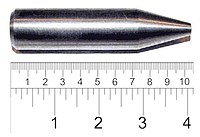
Photo from wikipedia
In September 2016, the National Institutes of Health (NIH) launched a 7-year extramural research program, Environmental influences on Child Health Outcomes (ECHO; https://echo.nih.gov). The ECHO Program has two major components,… Click to show full abstract
In September 2016, the National Institutes of Health (NIH) launched a 7-year extramural research program, Environmental influences on Child Health Outcomes (ECHO; https://echo.nih.gov). The ECHO Program has two major components, pediatric cohorts —focusing on observational research—and the IDeA States Pediatric Clinical Trials Network (ISPCTN)—focusing on interventional research. The program’s mission is to enhance the health of children for generations to come. ECHO’s goals are to (1) enable high-impact research evidence that will inform clinical practices, policies, and programs for child health and development; and (2) establish a national data platform and biorepository for the scientific community. This article discusses the observational research component of ECHO and introduces a series of three reviews appearing in this issue or forthcoming, each covering a different aspect of the ECHO Program. ECHO supports multiple synergistic, longitudinal studies to investigate how environmental exposures in early life—including physical, chemical, social, behavioral, biological, natural, and built environments—affect child health and development. ECHO science focuses on five key pediatric outcomes that have a high public health impact: (1) pre-, peri-, and postnatal outcomes; (2) upper and lower airway conditions; (3) obesity; (4) neurodevelopment; and (5) positive health. ECHO uses a collaborative team science approach to children’s health research. NIH designed the ECHO pediatric cohorts by leveraging existing longitudinal birth cohorts, and supporting expansion of recruitment and continued follow-up of pregnant women and their children. Through this new approach, NIH engaged researchers with expertise in participant engagement and innovative data and biospecimen collection. The ECHO pediatric cohorts comprise 31 NIH awards, supporting 69 unique birth cohorts that began enrolling over the past 25 years, many during pregnancy. Overall, the pediatric cohorts represent >57,000 child participants from diverse backgrounds across the United States. Cohorts are coordinated with and supported by a Coordinating Center, Data Analysis Center, Person-Reported Outcomes Core, Genetics Core, and the National Institute of Environmental Health Sciences (NIEHS) Human Health Exposure Analysis Resource (HHEAR; https://hhearprogram.org/). Given the variety of cohort-specific protocols, ECHO researchers developed an ECHO-wide Cohort Data Collection Protocol (EWCP), which supports a common approach to data and biospecimen collection, for all cohorts to implement. The EWCP specifies the data elements for ongoing data collection, as well as for submitting data and biospecimens that cohorts collected before ECHO onto the ECHO-wide cohort data platform. The protocol reflects a broad array of information on early-life exposures and ECHO intermediate, and targeted child health outcomes specified by life stage (pregnancy, infancy, early childhood, middle childhood, and adolescence). The protocol strikes a balance between depth and breadth of the data needed to answer child health research questions, while considering feasibility of data collection. The EWCP and forms are publicly available for all researchers at https://www.echochildren.org. The EWCP specifies a variety of essential and recommended biospecimens to collect at each life stage. ECHO developed biospecimen collection, processing, and storage guidance for blood, urine, stool, and placenta samples from pregnant mothers and their children. ECHO stores newly collected biospecimens in the ECHO biorepository managed by Fisher Bioservices. Cohorts also contribute previously collected biospecimens to ECHO-wide cohort science in two important ways: (1) by transferring existing bioassay data to the ECHO-wide cohort data platform and (2) by sending specific biospecimen samples to the HHEAR laboratories for approved ECHO-wide cohort analyses. NIH collaborates with the NIEHS HHEAR laboratories to perform state-of-the-art exposure bioassays for targeted and untargeted analytes. In coordination with ECHO researchers, HHEAR labs developed targeted multi-chemical panels (e.g., metals, plasticizers, pesticides, perfluorinated chemicals, nutrients, and tobacco biomarkers), special biomarkers (tooth assays that reconstruct past exposures in pregnancy), and untargeted chemical assays (e.g., metabolic biomarkers). ECHO investigators will use the bioassay data to establish ECHO-wide cohort population reference ranges, track exposure trends over time or by life stage, identify characteristics of participants with higher/lower exposures, and investigate relationships between exposures and children’s health outcomes in the ECHO-wide cohort. ECHO investigators periodically amend the EWCP to enhance and incorporate new data elements, such as those for rapid response to emerging public health needs. For example, ECHO investigators added data elements for medical record abstraction to support research on how early opioid exposure affects child health and development. In less than a month, ECHO developed surveys related to COVID-19 and obtained central IRB approval. Due to the interruptions in in-person visits during the COVID-19 pandemic, ECHO investigators are exploring innovative remote options to achieve ECHO goals for new data and biospecimen
Journal Title: Pediatric Research
Year Published: 2021
Link to full text (if available)
Share on Social Media: Sign Up to like & get
recommendations!